As people's demand for handling and comfort of cars continues to increase, there are more and more electronic devices in the car body, such as electric rearview mirrors, central locking, glass lifts, lights and more. Features, etc.
This article refers to the address: http://

Figure 1: System architecture of a typical body control module (BCM).
Power requirements and options
An important step in the design of a typical body control module (BCM) is to determine the power requirements and choose the right power solution. In general, BCM requires an input voltage between -0.5V and 32V and an output voltage of 5V or 3.3V. It is worth mentioning that there are more and more electric equipment in the car. If the quiescent current of the battery directly powered by the battery is not low enough, and the car is continuously parked for a long time, the car battery may not be restarted due to excessive discharge. Therefore, BCM design needs to consider quiescent current. In addition, automotive applications may often face high temperature environments, so power supplies are required to provide over-temperature protection.
Power supplies suitable for BCM include linear power supplies (or linear regulators) and switching power supplies (or switching regulators). These two power supplies have their own advantages. The choice of which power supply depends on the specific application. In terms of the power supply of the body control module, in the cars sold in the Chinese market, cars generally use 12V power, while trucks and buses generally use 24V power. In the 12V power supply BCM, it is recommended to use ON Semiconductor linear regulators, such as NCV4275A, see Figure 2. The NCV4275A is a 5V, 3.3V/450mA low dropout (LDO) linear regulator with reset and delay. This device supports programmable microcontroller reset and offers a variety of features such as overcurrent protection and overtemperature. Protection, short circuit protection, etc. In addition, a diode (MRA4005) is connected in series at position 1 in the figure below. This linear power supply can effectively prevent reverse voltages up to -42V; a transient voltage suppressor (TVS) tube can be connected in parallel at position 2 to effectively block up to + 45V transient power load dump (loaddump) high voltage pulse and unstable power supply clutter, in line with the ISO16750-2-20034.6 overvoltage test specification for 12V automotive power systems. In fact, a load dump can occur at the moment the car engine starts, causing the battery voltage to rise above 40V. These features make the NCV4275A ideal for automotive body control module applications.
In fact, the NCV4275A is only one of ON Semiconductor's wide range of linear regulators for automotive applications. Other linear regulators are such as NCV8664/5, NCV4949, NCV8503/4/5/6, NCV4274A, etc. Ultra-low static power products with quiescent currents as low as 30μA and drive currents ranging from 100mA to 450mA.
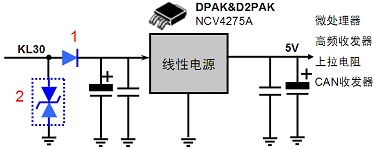
Figure 2: Schematic diagram of a typical application circuit for a linear power supply in a body control module.
In the BCM application of 24V power supply, it is necessary to convert the 24V voltage to 5V or 3.3V. If a linear regulator is used, the power chip itself will have a high power consumption, and a large amount of heat will cause the temperature to be too high to burn out the chip. We need to use switching regulators. We recommend the use of ON Semiconductor's switching regulators for automotive applications such as NCV51411, NCV8842, NCV8843, NCV33063, NCV33163, NCV3063, NCV3163, LM2576, LM2575 and NCV2574. These switching regulators have high efficiency, avoiding a large amount of heat release, protecting the chip and improving system reliability. The switching regulator drive currents for these automotive applications are mostly between 0.5A and 1.5A, some of which are 2.5A (NCV33163) and the switching frequency is between 50kHz and 300kHz. Taking the NCV51441 as an example, this device uses the V2 control architecture to provide unparalleled transient response, excellent overall regulation accuracy, and the simplest loop compensation. The “BOOST†pin on this device supports “Bootstrapped†operation to maximize energy efficiency; the integrated synchronization circuitry supports parallel power operation or minimizes noise.
Body network requirements and development trends
There are many types of system buses that can be used in automobiles, such as Controller Area Network (CAN), Local Interconnect Network (LIN), and FelxRay. The characteristics of these buses vary. Table 1 compares several common system buses in automotive applications and lists typical ON Semiconductor bus transceiver products.
Table 1: Comparison of different automotive buses and typical transceivers.
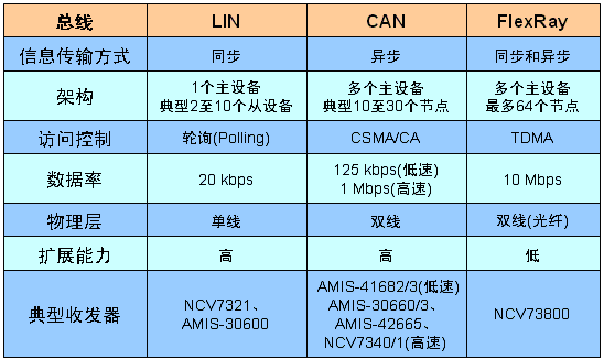
ON Semiconductor's line of transceivers is ideal for body control network applications. Figures 3a) and b) show typical circuits based on the ON Semiconductor CAN transceiver AMIS-42665 and the LIN transceiver NCV7321, respectively. It is worth mentioning that the AMIS-42665 provides a very low quiescent current of less than 10μA. Supports bus wake-up, common mode voltage range -35V to +35V, and can withstand electrostatic discharge (ESD) pulses rated at +/-8kV. The NCV7321 supports a voltage range of -45V to +45V and is capable of withstanding a 5kV ESD pulse. These devices offer powerful protection.
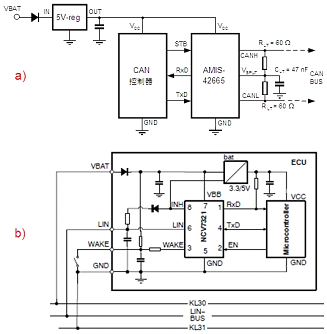
Figure 3: Typical CAN circuit (Figure a) and LIN circuit (Figure b) based on ON Semiconductor transceivers.
In the body control network application, it is necessary to reduce the cost and space requirements as much as possible, and at the same time improve the stability and long-term reliability of the system, so it is necessary to improve the integration of components. Thanks to the mixed-signal processes that have emerged in recent years, such as ON Semiconductor's SmartPower high-voltage BCD process, high-voltage analog circuits can now be integrated with low-voltage circuits, enabling the development and application of higher-integration system chips. For example, ON Semiconductor's NCV7440 integrates a linear regulator and a CAN transceiver on the same chip. The NCV7420 integrates a linear regulator and a LIN transceiver. This integration effectively saves PCB space and can separately supply power to the MCU, effectively curbing the interference of other modules on the MCU power supply.
As the world's leading supplier of high-performance, high-reliability silicon solutions, ON Semiconductor has introduced an ultra-highly integrated chip, the NCV7462, for automotive body control networking applications. The chip integrates a linear regulator, CAN transceiver, LIN transceiver, watchdog (WD) circuit, low-side drive and high-side drive to minimize the number of external components required, taking up very little Board space and help streamline the design process.
Remote locking and unlocking design requirements and solutions
The application of remote locking and unlocking in automobiles is becoming more and more popular. The body control module uses 315MHz (US, Japan) or 433MHz (Europe) frequency to achieve remote locking and unlocking functions through high frequency receiving and transmitting. The design challenge in this type of application is to design impedance matching circuits to minimize power loss. Common requirements for such applications include low quiescent current, providing sleep mode, low transmit power, high receive sensitivity, low power consumption, and a suitable frequency range. And ON Semiconductor's ON-53480 high-frequency transceiver meets these design requirements well, such as quiescent current as low as less than 1μA, with wake-up and sleep detection, signal level is only 10dBm, and receiving sensitivity is lower than - 100dBm, and the operating current is only 10mA, the frequency range is 280 to 343MHz.
Off-board high-power load drive and program comparison
The body control module board needs to supply some high-power loads outside the board, including automotive interior lighting (5W and 10W), one-way motors and car speakers. An alternative is to use an in-board relay. The coil of the relay is an inductive load, and the inductive load requires a starting current greater than the current required to maintain normal operation at startup, and the inductive load generates a back electromotive force at the moment of turning on or off the power. To drive the relay, use a relay driver such as ON Semiconductor's NUD3124, NUD3160 or NCV7608.
Table 2: Comparison of advantages and disadvantages of off-board high-power load drive scheme
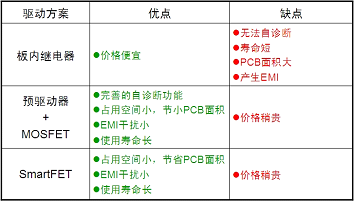
Another option is to use a "pre-driver + MOSFET" to drive off-board high-power loads. The pre-driver can be implemented with ON Semiconductor's NCV7513A, which supports parallel port and SPI port communication, programmable, and provides failure mode detection and short-circuit. And open circuit diagnostics.
The third option is to use a SmartFET driver. This is a protected MOSFET that adds a number of features to the MOSFET, such as overvoltage clamping, ESD protection, overcurrent protection, overtemperature protection, backpressure protection, and high-side and low-side drivers. Typical devices are the low-side drive NCV8401/2/3 and the NCV8450 and NCV8460 for high-side drive (with integrated boost circuit). The advantages and disadvantages of these three schemes are shown in Table 2.
Other solutions for BCM
In addition to the above-mentioned high-power off-board loads, the electric motorized mirrors commonly used in automotive applications can use ON Semiconductor's NCV7703 to drive the steering motors. The device offers three half-bridge outputs with an output current of 0.6A up to 1A and self-diagnostics for low quiescent current, SPI communication, and low/overvoltage/overtemperature protection.
In addition, the body control module needs to collect dozens of signals such as doors, locks, combination switches, etc., often need to expand the input port of the MCU, which requires a parallel port to serial port logic conversion chip, commonly used is 8 of ON Semiconductor Bit shift register MC14021B.
ON Semiconductor also offers different solutions for combined taillights. For example, the NCV7680 is an 8-channel low-side constant current driver that can set the tail travel/brake current output in pulse width modulation (PWM) mode, while the NSI45xx is a new constant current linear regulator (CCR) based on Anson. US Semiconductor's patent-pending self-biased transistor technology provides high performance with low cost, robustness, and the like, with a view to replacing the resistive drivers used in some automotive taillights.
to sum up:
The demanding body control module (BCM) imposes higher requirements on components. This paper explores the requirements of BCM design in power supply, body network and off-board high-power load drive, and compares the advantages and disadvantages of different solutions in some fields. ON Semiconductor is the world's leading supplier of high-performance, energy-efficient silicon solutions that provide robust protection, high reliability, and low quiescent current solutions for automotive applications such as body control modules, such as power regulators and buses. Transceivers, high-frequency transceivers, relay drivers, pre-drivers, motor drivers, LED drivers, and MOSFETs help designers choose the best component solutions for their BCM designs, giving them an edge in the market.

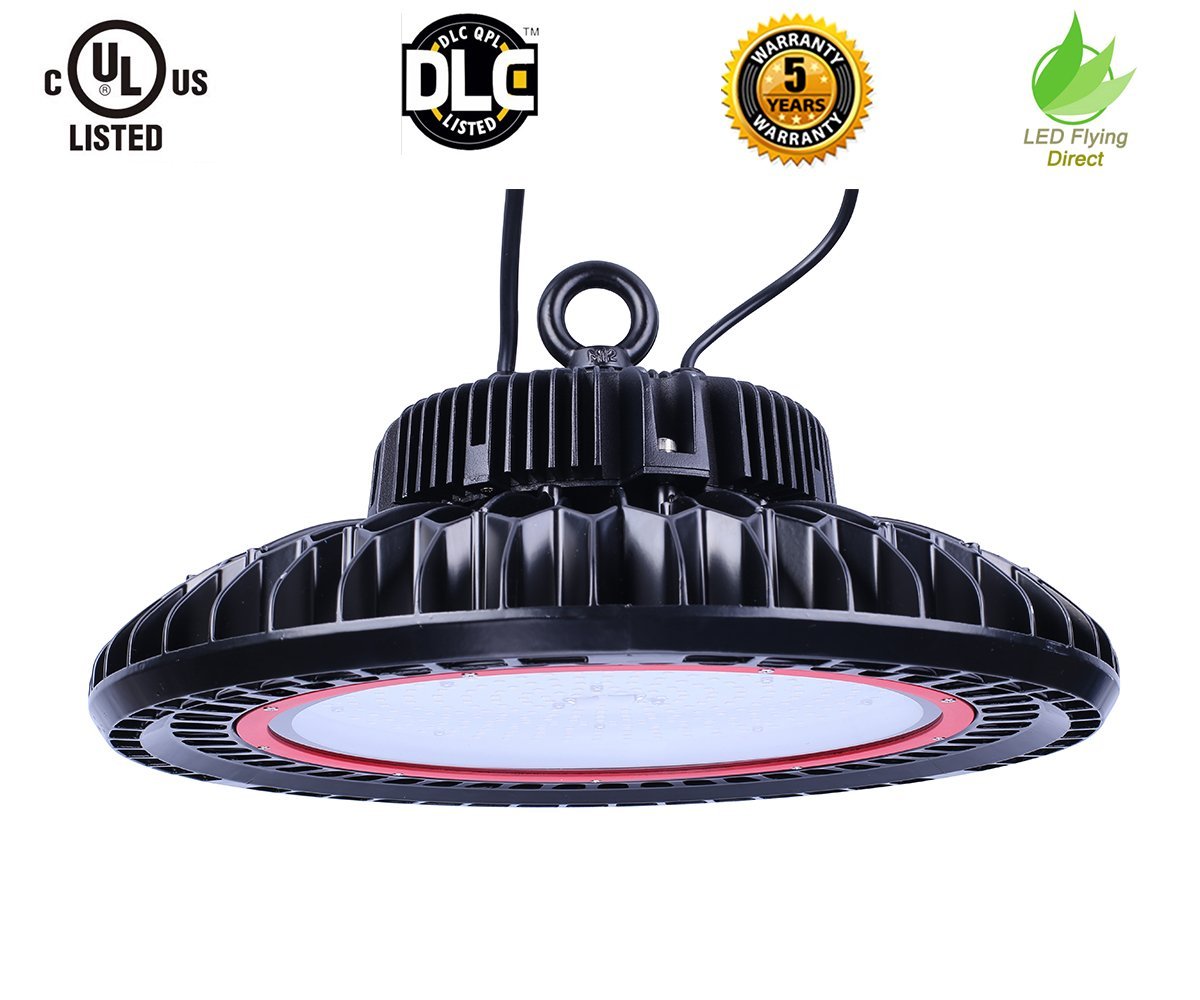
Application
Hygea UFO LED High Bay Light was designed specially to replace conventional light in a wide variety of industrial and warehouse applications.
Construction
*Robust die-cast aluminum luminaire body painted in epoxy powder coating in black.
*Air-flow heat sink allows for fast air movement as the perfect cooling system to ensure the performance and longevity.
*The luminaire assembly meets dust and moisture rating of IP65 per IEC60529 and impact protection of IK08 per *EN62262, ensure long life and protection from the environment.
*Rod mounting, hook with chain mounting and heavy duty steel yoke mounting are available.
General UFO LED High Bay Light
200W UFO LED High Bay Light,150W UFO LED High Bay Light,100W UFO LED High Bay Light
Shenzhen Hygea Technology Co.,Ltd. , http://www.hygealedlight.com